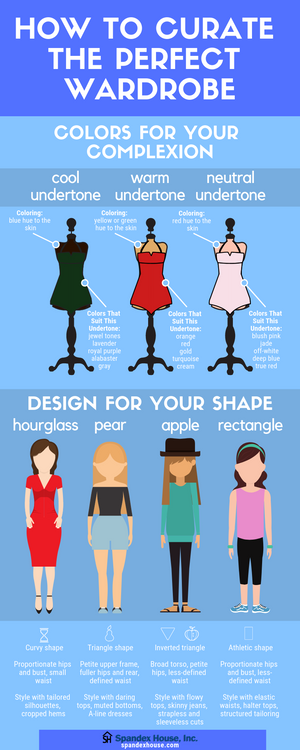
A cornerstone of an individual’s identity is how they express themselves through their clothing, whether preppy or punk or any style in between. For the particularly gifted, fashion can even be a creative outlet for self-expression. Designing clothes that fit your style—from spandex leggings to stunning gowns—can help you cultivate a unique and stylish wardrobe. To guide your collection, there are a few staples of fashion design worthy of consideration.
Choose Colors for Your Complexion
How to Determine Your Coloring
 When designing pieces for your wardrobe, it’s essential to consider your coloring when choosing swatches for your designs. A person’s distinct color palette blends their personal preferences with the hue of their skin’s undertones. Knowing which coloring category you fall under can help with choosing fabrics, not to mention other considerations, like finding foundation shades if you wear makeup.
When designing pieces for your wardrobe, it’s essential to consider your coloring when choosing swatches for your designs. A person’s distinct color palette blends their personal preferences with the hue of their skin’s undertones. Knowing which coloring category you fall under can help with choosing fabrics, not to mention other considerations, like finding foundation shades if you wear makeup.
An easy way to determine your undertones is to consider whether you think silver or gold jewelry suits your coloring better; silver will complement cool undertones better, while gold will go with warm undertones. Those with neutral undertones can wear both metals well and will usually gravitate towards one or the other based on personal preference.
Your palms can also indicate your coloring. With your palms facing up, a primarily blue hue to your skin means cool undertones; a yellow tint means warm undertones; and a red flush means neutral undertones. While you are free to choose any color you like, these guidelines can help you find shades that accentuate your coloring and make the most of your natural features.
Cool Undertones
People with cool-toned features will have a blue tinge to their skin tone. Typically, their coloring will range from very pale or very dark, and their natural hair color will be light blonde, deep brown, or blue-black. Those in the cool color family thrive in bright blues, emeralds, deep purples, rubies, and lavenders; their neutrals usually follow suit, gravitating towards grays and alabaster whites. As a result, they tend to steer away from those warmer hues—like orange or yellow.
Warm Undertones
People with warmer undertones will have a greenish or yellowish tinge to their skin. Those with tanner or olive complexions fit into this category, and their natural hair color typically ranges from darker browns to darker golden blondes. Their wardrobes lean toward oranges, reds, golds, olives, reddish purples, and turquoises, while creamier whites and taupes often round out their neutrals. In contrast, jewel tones and icier shades are harder to pull off with this coloring.
Neutral
Those whose coloring doesn’t quite match either category have the best of both worlds. They typically have hazel eyes that adapt to the shade they’re wearing, and their skin undertones have hints of both warm and cool. Blush-toned pinks, jade greens, off-whites, and lagoon blues often dominate their tastes, while oversaturated hues—like hot pinks and electric blues—can overwhelm their coloring. A true, fiery red, however, is a fantastic exception to that rule for neutral undertones, and will often be the standout shade for their wardrobe.
Design for Your Shape
Determining Your Body Type
 A clear understanding of how different styles will work with your physique is an imperative aspect of design. To determine which body type you fall under, you need to consider your measurements for your bust, your natural waist, and your hips. The proportions of these three features can help you to make tailoring decisions that flatter your figure best.
A clear understanding of how different styles will work with your physique is an imperative aspect of design. To determine which body type you fall under, you need to consider your measurements for your bust, your natural waist, and your hips. The proportions of these three features can help you to make tailoring decisions that flatter your figure best.
While the details below are a comprehensive outline of dressing for your shape, most women realistically fall under more than one of these categories. As a result, these guidelines should be more of a starting point for design rather than a rule book for your wardrobe.
Hourglass
Also known as a curvy shape, the hourglass figure describes women with a well-defined waist, proportionate hip and waist measurements, and a fuller bust, hips, and thighs. When dressing for this shape, you have two main goals: define your waist, and embrace your figure. On top, go for fitted or peplum tops and more tailored silhouettes. Cropped styles also work well for this shape, as do dresses that fall at your natural waistline (with a skinny-waist belt to draw attention to your curves). For pants, high-waisted jeans, as well as stretchy skinny jeans, are staple pieces. Fitted jumpsuits that capitalize on a spandex blend can also be a flattering way to accentuate your figure.
Pear
Pear shapes, your dainty torso yet fuller hips and rear allow for you to rock styles that would overwhelm other body types. On top, you’re aiming to focus attention on your narrow shoulders and waist with bold patterns and fun, daring cuts. Structured tailoring will define your curves and accentuate a petite upper frame, while a more muted, dark-wash pant will balance your proportions. Outerwear that lands at the mid-thigh, A-line skirts and dresses, and hemlines that hit just below your knee will also elongate your frame.
Apple & Inverted Triangle
These two body shapes are very similar, only diverging at the midsection. Both are characterized by broader shoulders, narrower hips, and a less-defined waistline, but true apple shapes also carry a little weight in their midsection as well. To accentuate your features with either frame, target your bust, arms, and legs and lean heavily into flowy pieces. Virtually anything that avoids a traditionally structured waistline will do the trick, while spandex leggings and skinny jeans will pair exceptionally well with this oversized, breezy aesthetic. Strapless and sleeveless cuts are a standout for these shapes, both for tops and dresses.
Rectangle
This body shape is also known as an athletic build, meaning you are well-proportioned like an hourglass shape but not particularly curvy. The key to accentuating a muscular figure is to create volume on top or bottom, not both. For example, if you wear a tight tank, balance it with flowy pants on bottom. For tops, pieces like halter, racerback, and strapless styles will draw attention to your toned arms and shoulders. Structured outwear can elongate your figure, while elastic waists or spandex styles will help create a more defined waistline.
Draw Inspiration From Your Favorite Designers
When organizing a collection of custom pieces, look towards your influences in the fashion world. Ready-to-wear collections that walk down the runways each Fashion Week produce a plethora of ideas to draw from—pushing the envelope for color combinations, cuts, and styles. Inclusive brands pave the way for people of all body types and aesthetics, but this branch of couture still has a long way to go before it encompasses the entire realm of fashion.
Designing your own clothes allows you to bridge that gap if you don’t fit into a stereotypical model aesthetic. Plus, it will enable you to make a design work specifically for you if, say, you love a unique neckline but would prefer a different waistline that goes better with your body type. It also presents an opportunity to play with fabrics, like offering a spandex blend alternative to what was originally a cotton-based design or choosing a paler colored fabric than the original to suit your cool undertones.
Selecting fabric is often the first step in a budding designer’s process. If your design plans to incorporate spandex fabric, Spandex House, Inc. is Manhattan’s iconic Garment District destination. As the largest wholesale spandex fabric supplier in the world, they have a vast selection that caters to projects of any size. For more information about their wholesale prices and to order samples, visit them online or call (212) 354-6711 today.
About the Business
Have a question? Ask the experts!
Send your question

